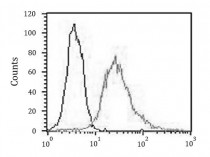ARG42124
anti-eEF1E1 / AIMP3 antibody
anti-eEF1E1 / AIMP3 antibody for Flow cytometry,ICC/IF,Western blot and Human,Mouse
Overview
| Product Description | Mouse Monoclonal antibody recognizes eEF1E1 / AIMP3 |
|---|---|
| Tested Reactivity | Hu, Ms |
| Tested Application | FACS, ICC/IF, WB |
| Host | Mouse |
| Clonality | Monoclonal |
| Clone | 1494CT639.147.31 |
| Isotype | IgG2b, kappa |
| Target Name | eEF1E1 / AIMP3 |
| Antigen Species | Human |
| Immunogen | Recombinant protein of Human eEF1E1 / AIMP3. |
| Conjugation | Un-conjugated |
| Alternate Names | Eukaryotic translation elongation factor 1 epsilon-1; Elongation factor p18; AIMP3; P18; Multisynthase complex auxiliary component p18; Aminoacyl tRNA synthetase complex-interacting multifunctional protein 3 |
Application Instructions
| Application Suggestion |
|
||||||||
|---|---|---|---|---|---|---|---|---|---|
| Application Note | * The dilutions indicate recommended starting dilutions and the optimal dilutions or concentrations should be determined by the scientist. | ||||||||
| Positive Control | HepG2 | ||||||||
| Observed Size | ~ 18 kDa |
Properties
| Form | Liquid |
|---|---|
| Purification | Purification with Protein G. |
| Buffer | PBS and 0.09% (W/V) Sodium azide. |
| Preservative | 0.09% (W/V) Sodium azide |
| Storage Instruction | For continuous use, store undiluted antibody at 2-8°C for up to a week. For long-term storage, aliquot and store at -20°C or below. Storage in frost free freezers is not recommended. Avoid repeated freeze/thaw cycles. Suggest spin the vial prior to opening. The antibody solution should be gently mixed before use. |
| Note | For laboratory research only, not for drug, diagnostic or other use. |
Bioinformation
| Database Links |
Swiss-port # O43324 Human Eukaryotic translation elongation factor 1 epsilon-1 Swiss-port # Q9D1M4 Mouse Eukaryotic translation elongation factor 1 epsilon-1 |
|---|---|
| Gene Symbol | EEF1E1 |
| Gene Full Name | eukaryotic translation elongation factor 1 epsilon 1 |
| Background | This gene encodes a multifunctional protein that localizes to both the cytoplasm and nucleus. In the cytoplasm, the encoded protein is an auxiliary component of the macromolecular aminoacyl-tRNA synthase complex. However, its mouse homolog has been shown to translocate to the nucleus in response to DNA damage, and it plays a positive role in ATM/ATR-mediated p53 activation. Alternative splicing results in multiple transcript variants. Read-through transcription also exists between this gene and the neighboring downstream MUTED (muted homolog) gene. An EEF1E1-related pseudogene has been identified on chromosome 2. [provided by RefSeq, Dec 2010] |
| Function | Positive modulator of ATM response to DNA damage. [UniProt] |
| Cellular Localization | Cytoplasm. Cytoplasm, cytosol. Nucleus. Note=Cytoplasmic under growth arrest conditions. Translocated into the nucleus when growth resumes (S phase) and following DNA damage. [UniProt] |
| Calculated MW | 20 kDa |
Images (3) Click the Picture to Zoom In
-
ARG42124 anti-eEF1E1 / AIMP3 antibody ICC/IF image
Immunofluorescence: 4% Paraformaldehyde-fixed, 0.1% Triton X-100 permeabilized HeLa cells stained with ARG42124 anti-eEF1E1 / AIMP3 antibody (green) at 1:25 dilution. Dylight® 554 Phalloidin (red) for cytoplasmic actin staining. DAPI (blue) for nuclear staining.
-
ARG42124 anti-eEF1E1 / AIMP3 antibody WB image
Western blot: 20 µg of HepG2 whole cell lysate stained with ARG42124 anti-eEF1E1 / AIMP3 antibody at 1:2000 - 1:4000 dilution.
-
ARG42124 anti-eEF1E1 / AIMP3 antibody FACS image
Flow Cytometry: HeLa cells were fixed with 2% paraformaldehyde (10 min) and then permeabilized with 90% methanol for 10 min. The cells were then incubated in 2% BSA to block non-specific protein-protein interactions followed by ARG42124 anti-eEF1E1 / AIMP3 antibody (right histogram) at 1:25 dilution for 60 min at 37°C, followed by incubation with DyLight®488 labelled secondary antibody. Isotype control antibody (left histogram) was Mouse IgG2b (1 µg/10^6 cells) used under the same conditions. Acquisition of > 10000 events was performed.








